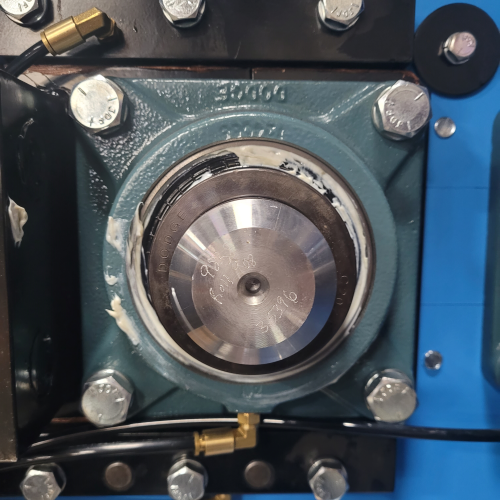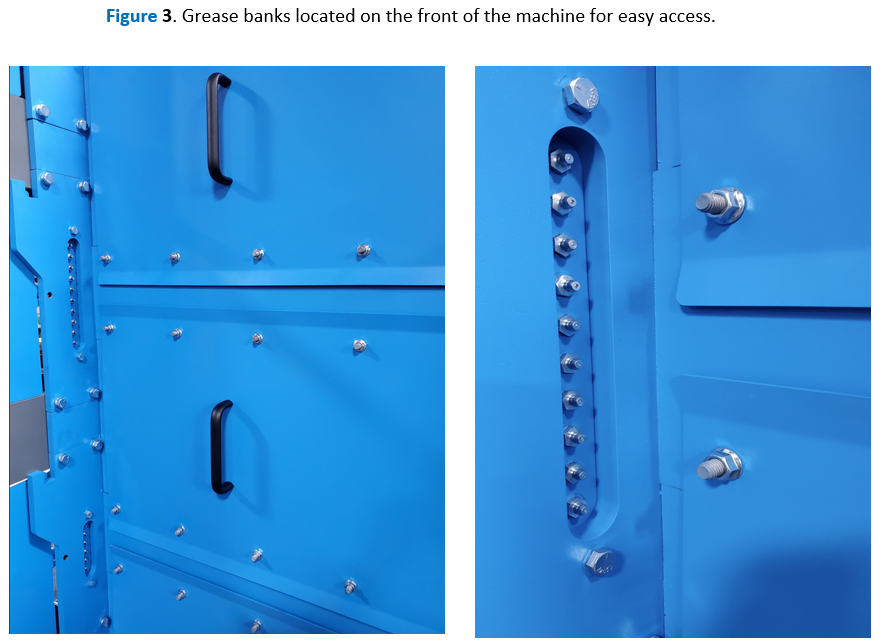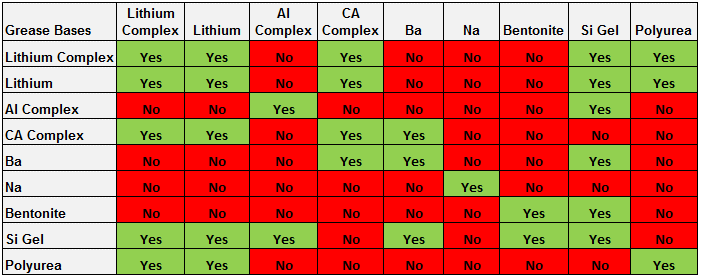Lubrication
Why Greasing is Important
The environment around roller grinder bearings is dirtier than standard bearing conditions.
As such, using a larger amount of grease to frequently purge (over-fill) the bearings helps to flush out contaminants from the inside of the bearing.
While bearings with more grease will run warmer, bearings with contaminants run even hotter and experience much more wear. It is better to replace a depleted grease tube than a bad bearing or the resulting broken roll shaft.
With this in mind, all bearings on all RMS Machines cannot be over-greased.
Any excess grease will purge through the seals on the front and rear of the bearing.
Purge simply means grease is leaking out of the bearing, and it signifies that the bearing is full of grease.
This purging is the best protection against bearing contamination. An example of a correctly lubricated bearing with grease purging around the seal is shown below.
Figure 1. A correctly greased bearing has grease purging around the perimeter.

In dirty environments around roller grinders, the manufacturer recommends frequently greasing the bearings to purge until fresh grease comes out.
Old grease will be discolored or dirty, whereas fresh grease will look nearly identical to what comes out of the tube.
Doing this ensures that your bearing has as little outside contamination as possible. The less foreign material entering your bearing, the better. Refer to the next page for greasing schedule recommendations.
Following this schedule should ensure that your bearings are fully greased. If fresh grease does not purge out of the bearing after 6-8 pumps, continue greasing.
Note: The greasing schedule that is shown below should be used as a basic starting point. All bearings should be monitored closely for temperature and the greasing schedule should be adjusted accordingly.
| Greasing Schedule | ||
|---|---|---|
| Hours Run Time Per Day | Pumps of Grease | Interval |
| 1-8 | 4 | Daily |
| 8-16 | 8 | Daily |
| 16-24 | 12 | Daily |
Purge bearings once every week!
Quick Tips for Greasing
- Grease bearings while the machine is running to ensure grease is evenly spread around the circumference of the bearing.
- Always wipe down grease zerks before greasing. Otherwise, any dirt on the grease zerks will be forced into the bearing.
- Bearings from RMS come greased and ready for operation. Bearings from the manufacturer should be greased until fresh grease comes out.
Other Lubrication Guidelines
- Feed roll bearings do not need to be greased as often as the main bearings that hold the corrugated rolls. Grease feed roll bearings once every month.
- Gearbox lubrication guidelines for feed rolls can be found in the Feed Roll section.
- Motor lubrication guidelines can be found in the Motors section.
Grease Lines
Inspect grease lines prior to greasing to make sure none have “blown out”.
If you notice a blown out grease line, install a grease zerk directly on the bearing and apply (2) pumps of grease.
The bearing may or may not take grease in this case, which is why the grease line blew out.
It is important to monitor the temperature of this bearing until it can be changed, possibly making it to the next roll change.
If the bearing takes grease, measure the blown out line and order a replacement. Replacement parts can be ordered from RMS.
Because of the maximum pressure (PSI) constraints of the RMS grease dispersion system, using a hand-operated grease gun is recommended.
If the use of an automatic or pneumatic grease gun is preferred, then it is necessary to insert a pressure reducing valve in-line between the grease gun and the supply air.
We recommend using an adjustable pressure (PSI) type not to exceed 100 lbs. This valve can be purchased from RMS.
Whether manual or automatic greasing is employed, this action should never replace visual inspection of the greased elements as the primary method of determining its effectiveness.
We recommend the creation of an inspection procedure to be carried out once a month, at a minimum.
This procedure will help aid your maintenance team in the identification and resolution of any problems related to greasing, such as a blown out grease line.
Figure 3. Grease banks located on the front of the machine for easy access

Grease Compatibility
Did you know you can’t mix just any grease with any other grease?
It’s true - doing so can cause catastrophic damage to equipment. And it’s true even if the grease types are the same.
Why is this the case?
Grease consists of two parts - the actual lubricant (normally oil) and a carrier, or base. Each has its own function.
It’s the bases that are not compatible.
Always know the base of the grease you are adding and the base of the grease you are adding to.
Once you know those things, you can use the compatibility chart below. A “Yes” indicates compatibility.
Figure 4. Table showing the compatibility of grease bases
